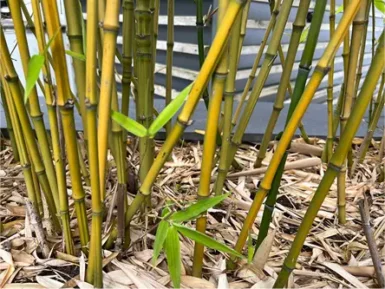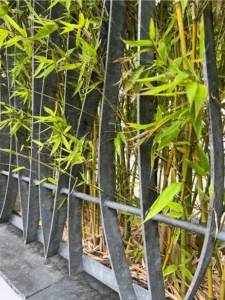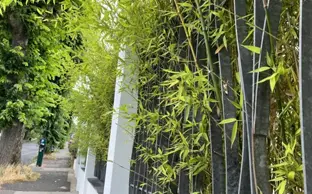How Does Bamboo Spread?
15-01-2025
How bamboo grows and spreads
Bamboo is known for its rapid and aggressive spreading capabilities, making it both a desirable plant for landscaping and a potential nuisance. Bamboo spreads primarily through its rhizomes, which are horizontal underground stems that send up new shoots and roots.
There are two main types of bamboo: ‘clumping’ and ‘running’; however, species known for clumping can run, and species known to typically run can clump.
- Running Bamboo: This type is invasive, with long rhizomes that spread extensively underground. It can quickly overtake gardens and neighbouring properties if not controlled. Common running species include Pseudosasa and Phyllostachys.
- Clumping Bamboo: Unlike running bamboo, clumping varieties grow in a tight cluster. While they spread more slowly, they can still expand over time.
Under certain conditions, bamboo can spread very easily.

How does bamboo multiply?
Rhizome propagation is the primary method for spread, with new culms (stalks) emerging from nodes on the rhizomes. This allows bamboo to cover large areas quickly, particularly for running varieties.
Does bamboo spread naturally?
Bamboo spreads naturally through its rhizomes, which grow horizontally beneath the soil. These rhizomes can cross barriers and emerge far from the parent plant. Environmental factors like soil quality, moisture, and temperature can accelerate this process. As can disturbance and physical factors, including gaps along fencing.
Will clumping bamboo spread?
Clumping bamboo spreads slower than running bamboo due to its shorter rhizomes, which grow in a tight, circular pattern. However, management is still required to prevent overgrowth, especially in small gardens. Also, sometimes, when stressed, clumping bamboo can send out rhizomes some distance from the main plant and become a running bamboo.
Controlling & stopping bamboo spread
Preventing bamboo from taking over your garden requires proactive measures. These include installing barriers, pruning rhizomes, and ongoing maintenance.
How to Stop Bamboo from Spreading in Your Garden
Stopping bamboo from spreading can be challenging due to its aggressive growth habits, especially for running bamboo varieties. Here are some effective strategies to control its spread:
How to stop a neighbour’s bamboo from growing in your garden
1. Install a root barrier
- Use a high-density polyethylene (HDPE) or metal barrier.
- Dig a trench along the property’s boundary or around the bamboo, and place the barrier vertically in the ground, leaving a lip above ground to prevent rhizomes from growing over it.
- The trench should be below the bamboo rhizomes; a depth of 1-1.5m is usually sufficient. Ensure the barrier is angled slightly outward at the top to deflect rhizomes upward instead of down. This makes them easier to spot and manage.
- Periodically inspect the barrier for any breaches or rhizomes attempting to escape.
2. Root pruning/cutting rhizomes
Rhizome pruning involves digging around the bamboo clump and cutting the underground stems. This prevents the plant from spreading to new areas. This may need to be done regularly and repeatedly if the bamboo is sending out runners. And if the bamboo is sending out runners we’d advise that they are also followed and removed.
3. Containment in planters
Plant bamboo in large, sturdy pots or planters to confine the roots and rhizomes. Ensure the containers are raised off the ground or placed on a solid surface to prevent rhizomes from escaping through drainage holes. If burying the pot, chose one without a drainage hole (as the rhizomes will just go down and out through that) and do not have it flush with the ground as the rhizomes can grow over the rim.
4. Chemical control
Use an appropriate herbicide, only as directed on the label. Apply it to freshly cut stems or leaves for best absorption. Repeated application may be needed to effectively kill the bamboo. Follow all safety and application instructions to avoid damage to surrounding plants.
5. Complete Removal
If bamboo has already spread extensively, consider removing the entire plant. Dig up the plants, ensuring you remove all rhizomes. We’d recommend that after the exaction the area is monitored so that any bamboo not removed can be acted on promptly.
If you’re planting bamboo, choose a clumping variety instead of a running one. Clumping bamboo has a less aggressive growth habit and stays in tighter clusters.
Bamboo shoots & rhizomes
How deep do bamboo roots go?
Bamboo roots typically grow up to 0.5m deep, but rhizomes can spread horizontally far beyond the visible plant. While roots are generally shallow, their density and toughness make them challenging to remove.
Can bamboo grow through concrete?
Bamboo can grow through cracks or weak points in concrete. While bamboo itself cannot break through solid, intact concrete, its underground rhizomes are incredibly strong and persistent. If there are pre-existing cracks, gaps, or weaknesses in the concrete, bamboo rhizomes can exploit these openings, exerting pressure as they grow and potentially worsening the damage over time.
Running bamboo varieties spread through underground rhizomes, which actively seek out paths of least resistance, including soft soil, cracks, or openings in barriers. When a rhizome finds a small gap, its growth can exert significant pressure as it expands, leading to cracking or widening of the existing opening.
Does cutting bamboo make it spread?
Cutting bamboo does not directly cause it to spread, but the way you cut it and manage the growth afterward can influence its behaviour.
Here’s what to consider:
- Cutting bamboo stalks (culms) without addressing the underground rhizomes can sometimes stimulate the plant to send out more shoots from the rhizome network. This is particularly true for running bamboo varieties, which spread aggressively through their rhizomes.
- If you cut bamboo above ground but leave the rhizomes in the soil, these underground structures will continue to grow and send up new shoots, potentially expanding the bamboo’s footprint.
- Cutting bamboo during its active growing season (spring and summer) can encourage rhizome growth as the plant focuses its energy on recovery and expansion.
How to remove bamboo roots
The process can be labour-intensive, especially for running bamboo varieties, but with persistence and the right tools, it can be done.
When excavating chase the rhizomes outward as they can extend several meters from the main plant. Carefully pull them up, being sure to remove the entire length of each rhizome, as even small fragments left behind can regrow. Either the full area can be excavated and removed, or if you wish to reduce the volume of material to be removed, you could sift through the soil to remove the bamboo pieces. If you do this be thorough, as missed fragments can lead to new growth.
Once the roots are removed, we strongly recommend to monitor the area for signs of regrowth. Any new shoots that emerge can be cut, pulled or treated with herbicides.
How Bamboo Roots Spread Can Damage Structures
Bamboo can grow under houses. Bamboo roots and rhizomes can grow into cracks in concrete, paving, and foundations, causing structural damage over time. They can also interfere with, and block, underground services.
Bamboo rhizomes are strong and grow outward in search of nutrients and space. If they encounter a crack or gap in a foundation, they can grow into it. As the rhizomes expand, they exert pressure, which can widen cracks and destabilise surrounding structures.
Bamboo tends to thrive in moist environments and can draw large amounts of water from the soil. This can cause localized soil drying and shrinkage, particularly in clay soils, leading to foundation settling or uneven support.
Why Uncontrolled Bamboo Spread is a Problem
The problem with invasive bamboo’s growing in a garden are that if the bamboo starts to run, the continuous growth of its rhizomes can disrupt nearby soil and potentially into and under extensions, patios, pathways and lawns.
Bamboo Legal Considerations
Whilst you don’t have to declare bamboo when selling a property, and bamboo does not directly affect mortgages, we are increasingly being contacted from sellers and buyers who are wanting the bamboo removed prior to the house sale as they have been alerted to the presence of the bamboo when it has been highlighted as a risk from the mortgage providers survey.
In the UK, bamboo encroachment onto neighbouring properties can lead to disputes.
You may be able to sue for damages caused by your neighbour’s bamboo, or be sued for bamboo encroaching from your property and causing a nuisance to others.
First we’d advise talking with your neighbour, and having an expert survey the affected growth as they may be able to offer a professional opinion which may help with the negotiations.
Whilst we cannot give legal advice, we have acted as expert witness for legal cases and can provide a list of law firms we have worked with should you require further professional assistance.

The Bamboo Growth Cycle
The lifecycle of bamboo involves several stages: rhizome expansion, shoot emergence, culm maturation, and eventual flowering.
Rhizomes grow horizontally underground, storing nutrients and forming the foundation for new shoots.
Shoots emerge in spring, growing rapidly to their final height. Once a culm matures, typically within one to three years, it becomes part of the plant’s support system, helping to sustain the growth of new rhizomes and shoots. Bamboo culms can remain productive for several years before naturally decaying.
Seasonally, bamboo exhibits distinct patterns of growth and dormancy. In spring and early summer, many species send up new shoots, which emerge from the ground and grow to their full height within a few weeks. During this period, the plant focuses its energy on vertical growth.
In late summer and autumn, bamboo shifts its energy to thickening the walls of its culms (stalks) and hardening them for structural support.
During winter, bamboo generally enters a period of dormancy, conserving its energy until the next growing season.
How Fast Does Bamboo Grow?
Bamboo is one of the fastest-growing plants, with some species capable of growing up to 90 cm in a single day under optimal conditions.
The specific growth rate depends on the species, climate, soil conditions, and water availability. Most bamboo species grow fastest during the warm, wet season when there is optimal water and sunlight. Running bamboo varieties spread aggressively through underground rhizomes, allowing them to colonize large areas quickly. Clumping bamboo grows more slowly and stays confined to tighter clusters.
Bamboo Has Regeneration Superpowers
Bamboo will re-grow when cut. One of bamboo’s most remarkable traits is its regeneration ability. Unlike many plants that require replanting, bamboo regenerates from its extensive rhizome system. After a culm is cut, new shoots will emerge from the rhizomes, often growing even more vigorously if the plant has adequate resources. This regenerative property makes bamboo a highly sustainable resource but also a challenging plant to control when managing its spread.
If you’re concerned about bamboo spreading in or onto your property, our bamboo removal specialists can help; contact us now for free advice.

